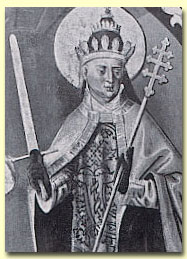 The author of the Liber Pontificalis calls St. Sixtus a Greek
and a philosopher, but modern scholars think that Pope Sixtus is confused
with another Sixtus, a Pythagorean philosopher. Whether a philosopher or
not, Pope Sixtus II was a glorious martyr.
The author of the Liber Pontificalis calls St. Sixtus a Greek
and a philosopher, but modern scholars think that Pope Sixtus is confused
with another Sixtus, a Pythagorean philosopher. Whether a philosopher or
not, Pope Sixtus II was a glorious martyr.
St. Stephen had caused a good deal of excitement by his threat to excommunicate
those bishops who did not conform in the matter of heretical baptism. St.
Firmilian of Antioch had written a bitter letter to Stephen. St. Dionysius
of Alexandria had written a mild letter pleading for mercy and forbearance.
To St. Sixtus II, Dionysius addressed a similar appeal. His words were
heeded. Pope Sixtus II, though he upheld the traditional Roman doctrine,
did not break off relations with those African and Asiatic churches which
followed St. Cyprian.
Sixtus felt the full force of Valerian's persecution. That emperor
had issued his second more drastic edict of persecution in 258. Soon blood
was flowing. Since the Cemetery of Calixtus was too well known to government
officials for safety, Pope Sixtus held services across the Appian Way in
the Cemetery of Praetextatus. This cemetery seems to have been private
rather than Church property. The precaution, however, was in vain. One
day when Pope Sixtus was giving a talk to the faithful, the police broke
in, arrested Sixtus and his chief clerics, and carried them off to the
prefect. On this occasion they do not seem to have bothered about the lay
people. According to tradition, the touching scene between St. Sixtus and
his chief deacon, St. Lawrence, occurred at this time. Lawrence was absent
when the police made their swoop. On hearing the news, he hastened to meet
the Pope and asked him, "Where are you going, father, without your
son? Where are you going, O priest, without your deacon?" Pope Sixtus
replied, "My son, you I am not abandoning. Greater strife awaits you.
Stop weeping; you will follow me in three days" (Paul Allard, Les
dernieres persecutions du troisieme siecle, p. 91). And so it happened.
The police pounced on St. Lawrence and put pressure on him to deliver up
the treasures of the Church. St. Lawrence agreed to lead the prefect to
the treasures, and since the reserve money of the Church had been distributed
to the poor, Lawrence, even as Cornelia pointed to her children as her
jewels, pointed to the poor as the Church treasure. The prefect was disappointed.
Lawrence met death like a hero.
Pope St. Sixtus II was put to death on August 6 in the cemetery where
he had been holding services. He was buried, however, in the Cemetery of
Calixtus. His feast is kept on August 6, the anniversary day of his martyrdom.
Excerpted from "Popes
Through the Ages" by Joseph Brusher, S.J.

